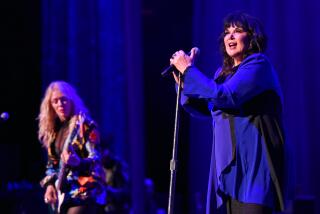Margaret Thatcher, Annette Funicello and the spectrum of sisterhood
While former Secretary of State Hillary Rodham Clinton considers the pros and cons of trying, once again, to become this nation’s first female president and Julia Louis-Dreyfus returns as the bumbling but pencil-skirt-rocking fictional vice president in HBO’s “Veep,” a strange day took from us two women who helped a generation redefine what it meant to be a woman.
It’s difficult to imagine former British Prime Minister Margaret Thatcher and former Mouseketeer and pop music star Annette Funicello sharing much beyond today’s obituary page — Thatcher died Monday, at 87, of a stroke; Funicello, at 70, of complications arising from multiple sclerosis. But as disparate as their careers and legacies were, they each contributed to shifting ideals of femininity and a modern women’s movement often as dismayed by its successes as its failures.
For many women who came of age in the 1960s, Funicello was the last of the wide-eyed good girls. She was perky rather than sassy, pretty in a non-threatening and enthusiastically demure way that the crosshatched forces of the women’s and sexual liberation movements took great pleasure in parodying.
PHOTOS: Annete Funicello - Career in pictures
“Would you pull that crap with Annette?” asks “Grease’s” Rizzo in the show’s most socially aware song, eternally linking Funicello with that era’s other symbol of repressed womanhood, Sandra Dee.
Funicello was the girl we left behind before we found greater truth at the feet of Janis Joplin. Eternally imprinted on the cultural imagination in her Mouska-ears and bobby socks, then her modest “Beach Blanket Bingo” two-piece, she was the black-and-white portrait of a nation’s carefully groomed and hypocritical moments of innocence before it gave way to the psychedelic world of protest placards and love beads, questionable hygiene and reconsideration of everything.
It was easy to love Annette, but only in the past tense. As the world changed, she and her Mouska-friends quickly became nostalgia personified.
Not so Margaret Thatcher, a woman of the same conservative constructs that created Annette and Sandra Dee, but one writ large and wielding great power, the kind of power so many women of the 1960s and ‘70s were demanding for members of their gender.
Her pearls and beauty-parlor coif stiffly mirroring the traditional nature of her Tory politics, Thatcher posed a devastating conundrum for feminists. Although they claimed her numerically, counting her with Golda Meir, Indira Gandhi, and later Ireland’s Mary Robinson as examples of our own country’s backwardness, they rejected Thatcher spiritually.
Thatcher, with her union-busting ways, commitment to small government and steely stance against the Irish problem, burst the Marge Piercy-esque, feminist utopian vision of what the world would look like if women ran things.
PHOTOS: Margaret Thatcher | 1925 - 2013
For generations, many liberal poets, writers and reformers assumed that an increase in female leaders would somehow magically solve myriad problems. Without such an overdose of testosterone in high places, gatherers would balance out the hunters and political posturing would give way to political nurturance.
Women leaders would groove like Gloria Steinem and follow a more Carol Gilligan model of gender differentiation, celebrating the communal rather than the competitive. They’d use diplomacy rather than militaristic might, and generally lead the world in a kinder, gentler fashion.
Then Thatcher came along and blew that idea to bits.
Liberal women were trapped between their desire to applaud the will and determination that allowed the Iron Lady to break the glass ceiling and their dismayed rejection of her actual policies. If the personal was the political, what in the world was Margaret Thatcher? Other than, as the joke went, Ronald Reagan in a dress.
Thatcher, and the reactions she evoked, forced many to re-examine their definition of feminism. Did we truly want simple equality for the sexes or was there a more specific agenda in place? Was Thatcher a triumph of the women’s movement or its own worst nightmare?
Either way, the idea that women who chose to follow a politically conservative path were at best unenlightened and at worst co-opted by the patriarchy (radical feminist theologian Mary Daly called them “fembots”) illuminated the disturbing possibility that the feminist image of womanhood was just as narrow as the ones many worked so hard to replace.
That recognition, and the very real gains of the women’s movement including greater access to education, economic independence and political power, has broadened the definitions more organically, creating an ever-lengthening spectrum of possibility, one in which a woman can be sweetly wide-eyed but politically radical or tart-tongued feisty but socially conservative.
And whether we like it or not, we owe as much to Annette as we do to Janis, as much to Maggie as to Gloria. Equality is not the same as homogeneity and the only true ideal for femininity is the absence of an ideal.
PHOTOS, VIDEOS & MORE:
Real places, fake characters: TV’s bars and eateries
PHOTOS: ‘The Ellen DeGeneres Show’ through the years
PHOTOS: Violence in TV shows
More to Read
The complete guide to home viewing
Get Screen Gab for everything about the TV shows and streaming movies everyone’s talking about.
You may occasionally receive promotional content from the Los Angeles Times.







